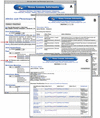MGD: the Mouse Genome Database
- PMID: 12519980
- PMCID: PMC165494
- DOI: 10.1093/nar/gkg047
MGD: the Mouse Genome Database
Abstract
The Mouse Genome Database (MGD) (http://www.informatics.jax.org) one component of a community database resource for the laboratory mouse, a key model organism for interpreting the human genome and for understanding human biology. MGD strives to provide an extensively integrated information resource with experimental details annotated from both literature and on-line genomic data sources. MGD curates and presents the consensus representation of genotype (sequence) to phenotype information including highly detailed information about genes and gene products. Primary foci of integration are through representations of relationships between genes, sequences and phenotypes. MGD collaborates with other bioinformatics groups to curate a definitive set of information about the laboratory mouse. Recent developments include a general implementation of database structures for controlled vocabularies and the integration of a phenotype classification system.
Figures

References
-
- Denny P. and Justice,M.J. (2000) Mouse as the measure of man? Trends Genet., 16, 283–287. - PubMed
-
- Naf D., Krupke,D.M., Sundberg,J.P., Eppig,J.T. and Bult,C.J. (2002) The Mouse Tumor Biology Database: a public resource for cancer genetics and pathology of the mouse. Cancer Res., 62, 1235–1240. - PubMed

